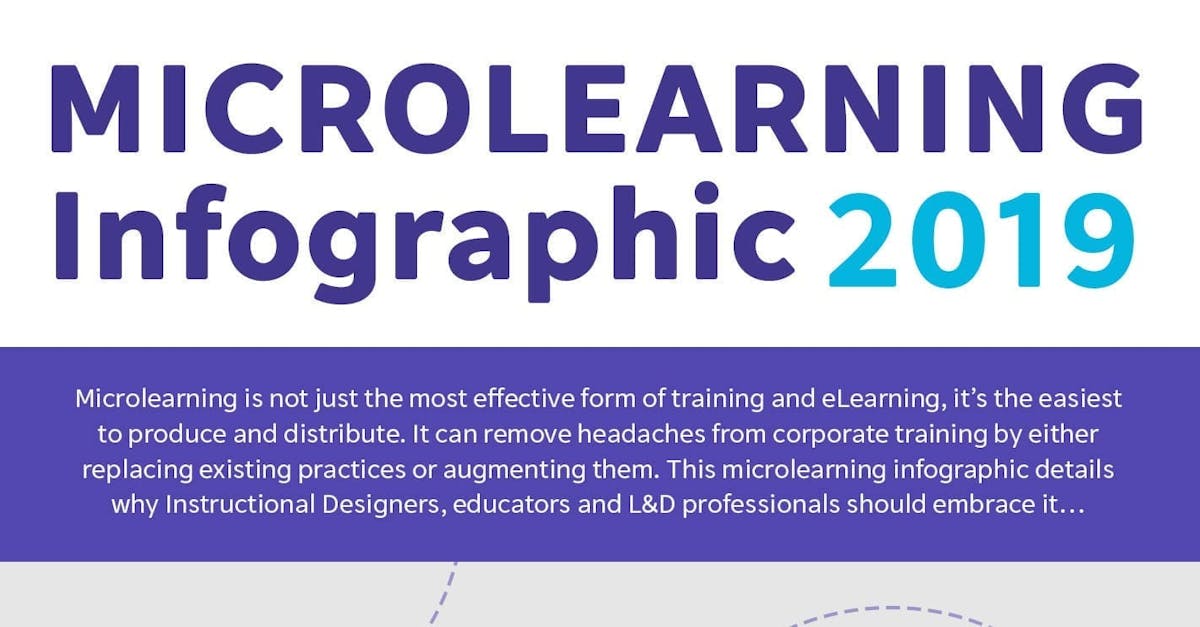Microlearning Infographic 2019

Microlearning is not just the most effective form of training and eLearning, it’s the easiest to produce and distribute. It can remove headaches from corporate training by either replacing existing practices or augmenting them. This microlearning infographic 2019 details why Instructional Designers, educators and L&D professionals should embrace it…
Download the full size Microlearning Infographic 2019 below

What’s in the Microlearning Infographic 2019?
What is microlearning?
Microlearning is the practice of reducing lessons into small, easily-absorbed, bite-sized chunks.
Why is it so effective?
Short-term memory can only retain about four new pieces of information at once. After that, knowledge is pushed out or overwritten meaning that it’s less likely to be transferred to long-term memory.
How to use it
The best way to engage with microlearning is with a mobile-focussed Learning Management System (LMS). This way, microlearning can leverage the interactive, touchscreen-enabled power of ubiquitous smartphone ownership to create engaging microlessons and easily distribute them to a global userbase.
Tips and tricks
Video – Use multimedia and video to make knowledge transfer more engaging.
Interactive – Interactive lessons are much more engaging and effective.
Gamification – Scores for correct answers and fastest completion times make learning not feel like learning.
Reinforcement – Reinforce everything regardless of whether an answer is right or wrong.
Mobile – Microlearning on a mobile device means microlessons can be completed anywhere, anytime and, importantly, at a learner’s own pace.
Peer learning – Experts say 30% of all learning should come from peers: after all, your organisation’s own workers know your organisation best.
Keep it short – Break complex topics down into multiple courses and lessons so they can be addressed one chunk at a time.
Spaced Repetition – Improve long-term knowledge retention by periodically repeating short microlessons.
Engaging user experience – Microlearning enables the use of interactive and gamified templates to make existing lesson content more engaging.
Real rewards – Prizing can be implemented by offering rewards to those who complete courses the quickest, with the highest score or before a deadline.
Rapid Authoring – No more paying specialists to produce courses over the span of many weeks: author in the morning, distribute in the afternoon with microlearning.
Competition and Leaderboards – Add a competitive element to training with leaderboards showing the best performers.
Cloud A.I.-based translation – Translating eLearning courses into multiple languages is time consuming and expensive. With microlearning, it can usually all be done instantly in the cloud.
Analytics – Immediately see how effective lessons are and how learners have performed. No more isolated Instructional Designers who can’t react to failing courses.
Completion rates – Typical eLearning courses have completion rates under 20%. Microlearning courses regularly hit 90%.
Value – Microlearning software and related services typically cost much less than older, less-agile authoring tools and learning management systems.
Applications
- Augment existing training by using microlearning for reinforcement and embedding knowledge.
- Train entire workforces remotely on new skills, practices and policies.
- Make education fun and engaging for young and old learners alike.
Feel free to use this Microlearning Infographic 2019 for your own work!
To find out more about microlearning get in touch at enquiries@edapp.com. You can also try EdApp’s Mobile LMS and authoring tool for free by signing up here or in the box below.
[wpipa id=”815″]
Curated course examples
Author
Guest Author Daniel Brown
Daniel Brown is a senior technical editor and writer that has worked in the education and technology sectors for two decades. Their background experience includes curriculum development and course book creation.
